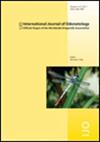来自中国云南的Bayadera strigata Davies & Yang, 1996的末龄幼虫(蜻蜓目:鞘翅目:大戟科)
IF 1
4区 农林科学
Q3 ENTOMOLOGY
引用次数: 0
摘要
本文首次描述了产自中国云南省的Bayadera strigata Davies & Yang(1996年)的末龄幼虫,并绘制了插图。本研究证实了 Bayadera 属的几个典型特征或独特特征,并与其他属进行了比较讨论。B.strigata幼虫与同属的区别在于其生殖器上有许多明显的短刺,但没有长刺。雌雄两性的性腺都异常长。报告还提供了有关该物种栖息地和行为的说明。研究材料将保存在中国云南大理大理大学生物科学博物馆。本文章由计算机程序翻译,如有差异,请以英文原文为准。
The final-instar larva of Bayadera strigata Davies & Yang, 1996 from Yunnan, China (Odonata: Zygoptera: Euphaeidae)
The final instar of Bayadera strigata Davies & Yang, 1996, from Yunnan Province, China, is described and illustrated for the first time. This study confirms several characters as being typical of, or unique to, the genus Bayadera and discusses them in comparison to other genera. The larva of B. strigata is distinguished from its congeners by the presence of numerous distinct short spines on the genae, but no long spines. The gonapophyses are unusually long in both sexes. Notes on this species’ habitat and behaviour are provided. The material examined will be stored at the Bioscience Museum of Dali University, Dali, Yunnan, China.
求助全文
通过发布文献求助,成功后即可免费获取论文全文。
去求助
来源期刊

International Journal of Odonatology
ENTOMOLOGY-
CiteScore
2.30
自引率
0.00%
发文量
15
审稿时长
>12 weeks
期刊介绍:
International Journal of Odonatology (IJO) is aimed at providing a publication outlet for the growing number of students of Odonata. It will address subjects such as the ecology, ethology, physiology, genetics, taxonomy, phylogeny and geographic distribution of species. Reviews will be by invitation, but authors who plan to write a review on a subject of interest to the journal are encouraged to contact the editor.
 求助内容:
求助内容: 应助结果提醒方式:
应助结果提醒方式:


